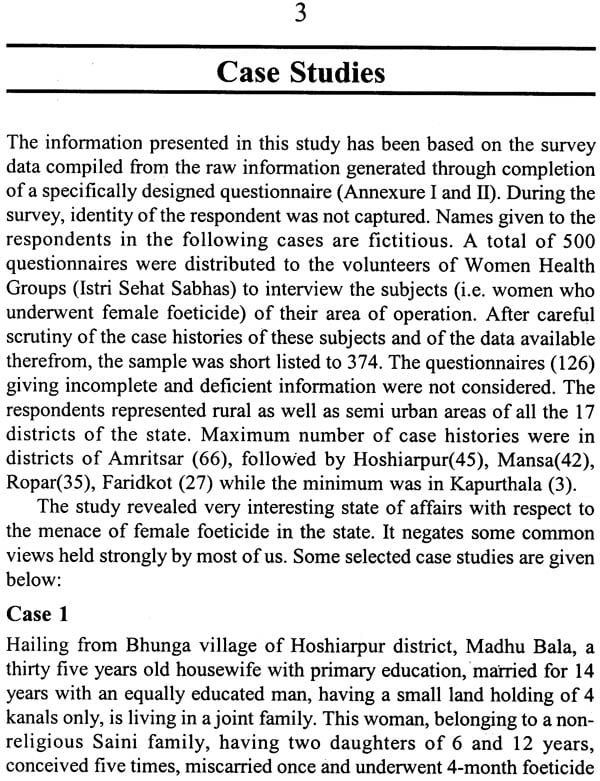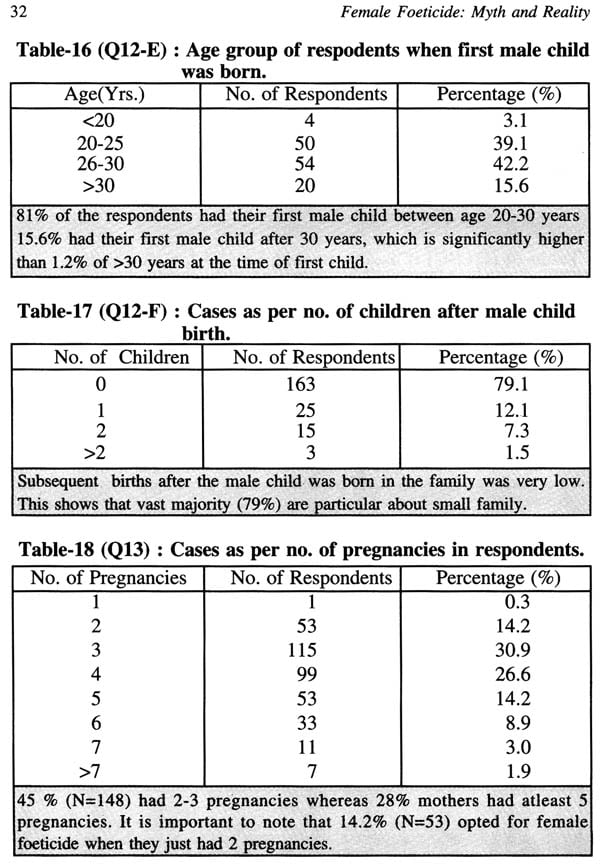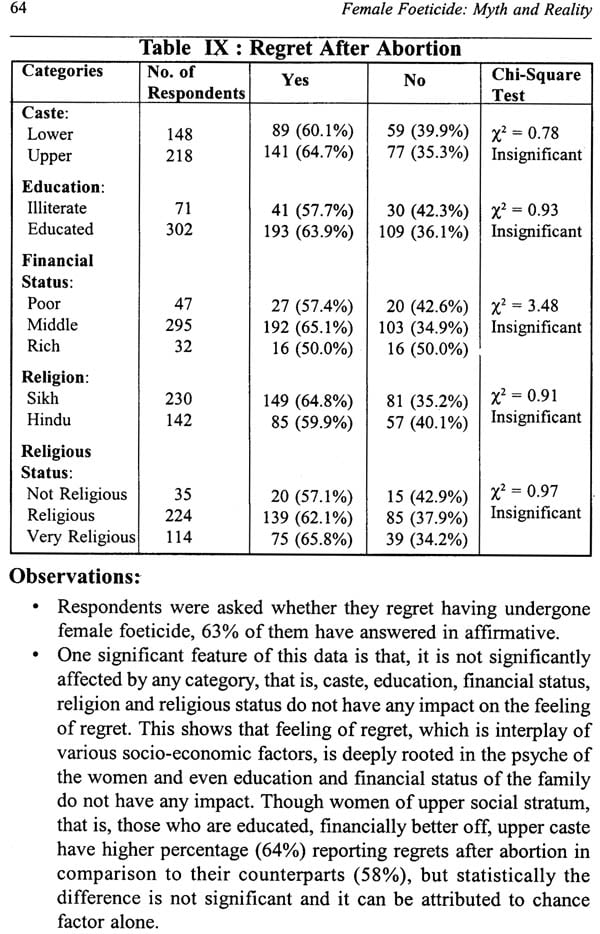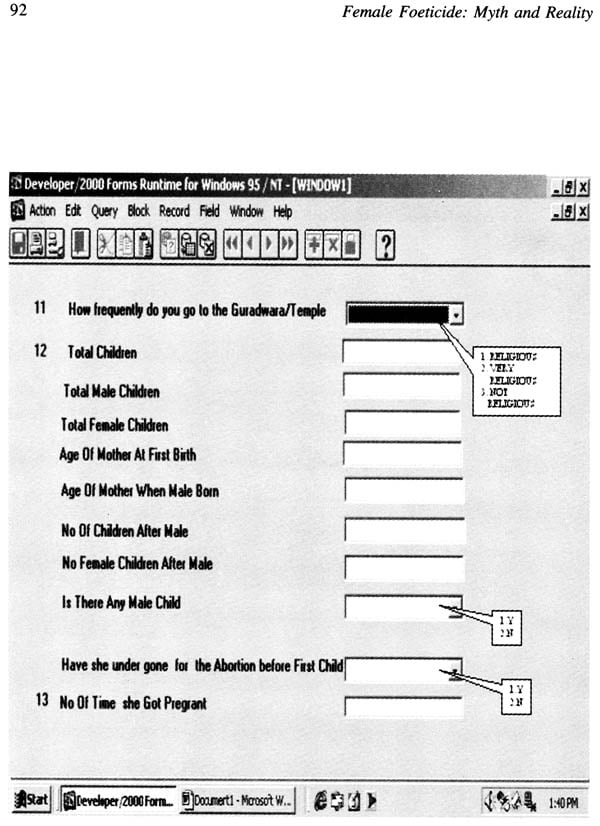
Female Foeticide Myth and Reality: 374 case histories of women who have undergone female foeticide in Punjab, India.
Book Specification
| Item Code: | IDJ431 |
| Author: | Anurag Agarwal |
| Publisher: | Sterling Publishers Pvt. Ltd. |
| Edition: | 2003 |
| ISBN: | 8120725743 |
| Pages: | 104 |
| Cover: | Hardcover |
| Other Details | 9.4" X 6.4" |
| Weight | 360 gm |
Book Description
From the Jacket:
This book is an analytical outcome of the interviews with 374 women who had undergone female foeticide. A comprehensive questionnaire was prepared and the interviews were taken by the volunteers of Istari Sehat Sabhas (Women Health Groups) - a village level NGO. The responses were classified into discrete categories to enable quantitative analysis. A statistical test was conducted to see whether certain responses such as, consent for abortion, feeling of regret after abortion and realisation that foeticide is a sin, are significantly effected by socio-economic parameters such as, education, financial status, religiosity, etc. The study has exploded many myths and negated several beliefs and perceptions held by most of us. For example, we think that female foeticide is done with the consent of the mother, but the study reveals that 75% of the women are forced into it. Another common perception held by most of us is that people belonging to lower strata of the society are crude in their behaviour, and their women are the ones mostly pressurised but the truth is otherwise - women belonging to upper caste and rich families are pressurised even more to commit female foeticide by their family members.
The book gives and in-depth insight into the psyche of the women who had undergone female foeticide. It brings out how the thinking and perception of all these women is different from the rest.
Back of the Book:
Patient Care in India (A Case Study of Government Hospitals in Punjab)
A prescription by a doctor may be taken as a reflection of physicians attitude to the disease and the role of investigation and drug in its treatment. It also provides and insight into the nature of health care delivery system. Prescription surveys are one of the pharmacoepidemiological methods, which provide a relatively unbiased picture of prescribing habits. This kind of survey allows the identification of areas with aberrant or sub-optimal prescribing habits, for further evaluation.
The present survey, the first of its kind of Government Hospitals in Punjab, which cater to the secondary health services in the state, was undertaken with the objectives to find the morbidity, disease pattern, drug utilization and generate database for prescription practices in diseases.
The survey covered a representative sample of 100,053 OPD prescriptions from 45 hospitals. The report presents survey findings, and the contents of this report have been compiled in the form of a book after approval from the various concerned Departments of Post Graduate Institute of Medical Education and Research, Chandigarh; Dayanand Medical College, Ludhiana and Christian Medical College, Ludhiana.
About the Author:
Anurag Agarwal is a graduate engineer from Indian Institute of Technology (IIT), Kanpur. He later joined the Indian Administrative Service (IAS). He was Managing Director of the Punjab Health Systems Corporation (PHSC), responsible for management and control of 156 secondary level government hospitals having bed capacity ranging from 30 to 400 beds. He was also project director of a World Bank assisted project of about $ 100 million, to revamp and modernise the secondary level health care in the state of Punjab. He was also Head of the Department for a prestigious 800 bedded Institute of Mental Health at Amritsar.
Currently he is the Deputy Commissioner, Bathinda, Punjab.
Preface:
Punjab has one of the most adverse sex ratios in the country. Overall sex ratio in the state is 874 females per 1000 males and it shows further declining trend in the children. Sex ratios for the age groups of 0-6 years and 0-1 years are 793 and 747, respectively. Through abuse of ultrasound scanning, parents are going for sex selective abortions. Every year more than one hundred thousand female fetuses are killed in Punjab.
The book is based on the interviews of 374 females who had undergone female foeticide. These interviews based on comprehensive questionnaire were taken by the volunteers of Istri Sehat Sabhas (Women Health Groups). To understand the psyche of these women, quantitative tools were applied to analyse how certain socio economic factors such as caste, education, financial well being, etc affect the thinking and perception of these women.
The findings of the study negate many of the common beliefs and perceptions strongly held by most of us. For example, there is strong religions advocacy on this issue based on the presumption that women who undergo female foeticide do not realise that it is a sin and if they were made to realise it, they would not commit the sin of female foeticide. The reality is that 85% of the women who had undergone female foeticide already had the realisation that it was a sin. This is the reason why the present form of religious advocacy has not worked.
Gender bias is the interplay of various socio-economic factors and is deeply rooted in our mindset. Modern medical technology has worked as a catalyst to metamorphose strong preference for a male child, with desire for a small family, into female foeticide. In this book I have tried to give and insight into the psyche of the women who had undergone female foeticide, which is essential to have any successful strategy to combat this menace.
| Acknowledgements | vi | |
| Preface | ix | |
| 1. | Female Foeticide and Sex Ratio | 1 |
| 1.1 Introduction | ||
| 1.2 Misuse of Reproductive Technology | ||
| 1.3 Gender Bias | ||
| 1.4 Indian Sex Ratio | ||
| 1.5 Why Male Preference is Particularly Dominant in Punjab? | ||
| 1.6 A Mathematical Formulation | ||
| 1.7 Social Dimensions of the Problem | ||
| 2. | The Study | 9 |
| 2.1 Need for the Present Study | ||
| 2.2 Objective of the Study | ||
| 2.3 Mode of Survey | ||
| 2.4 Methodology | ||
| 2.5 Training of Istri Sehat Sabhas (Women Health Groups) | ||
| 2.6 Survey | ||
| 3. | Case Studies | 12 |
| 4. | Analysis | 26 |
| 4.1 Computerisation of the Data | ||
| 4.2 Results and Observations | ||
| 4.3 Statistical Test - Chi Square Test | ||
| 4.4 Summary and Conclusion | ||
| Annexure I: | Filled in Questionnaire in Punjabi | 77 |
| Annexure II: | Questionnaire in English | 84 |
| Annexure III: | Front End Forms | 91 |









